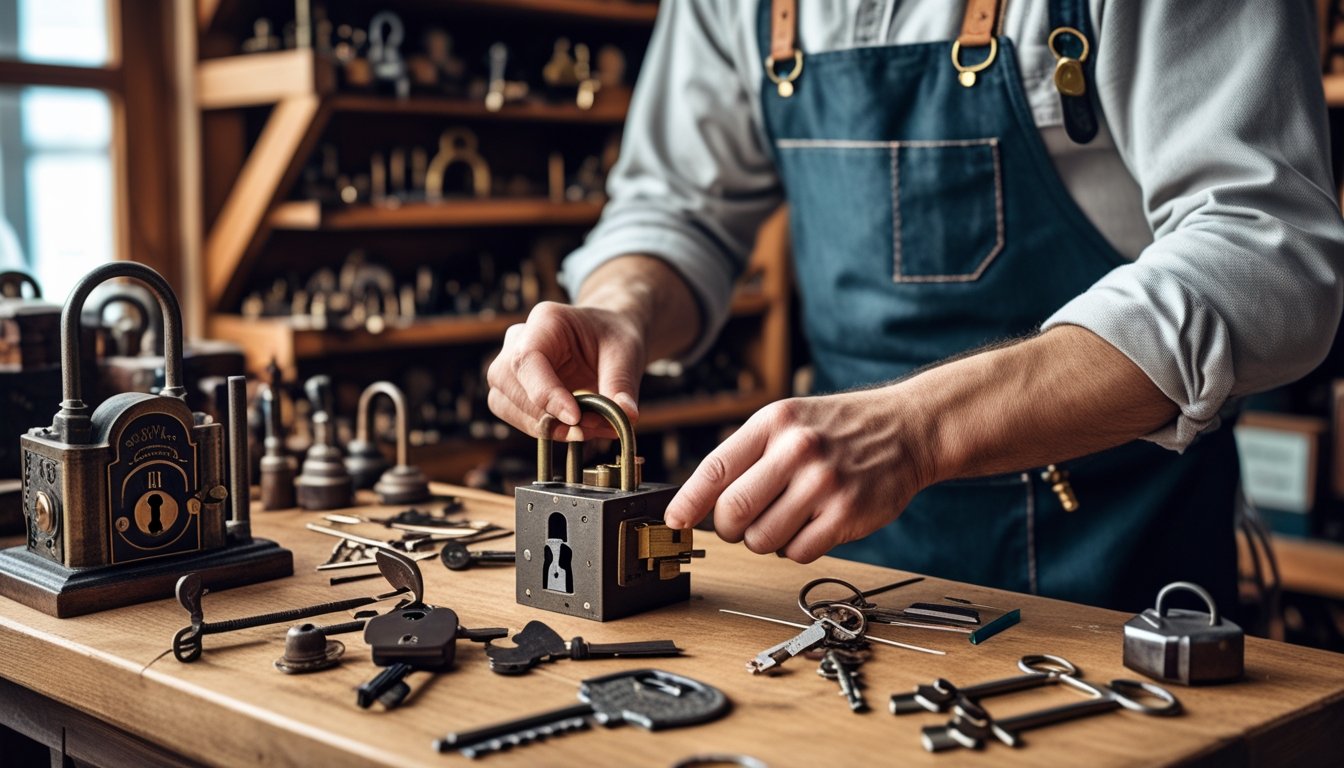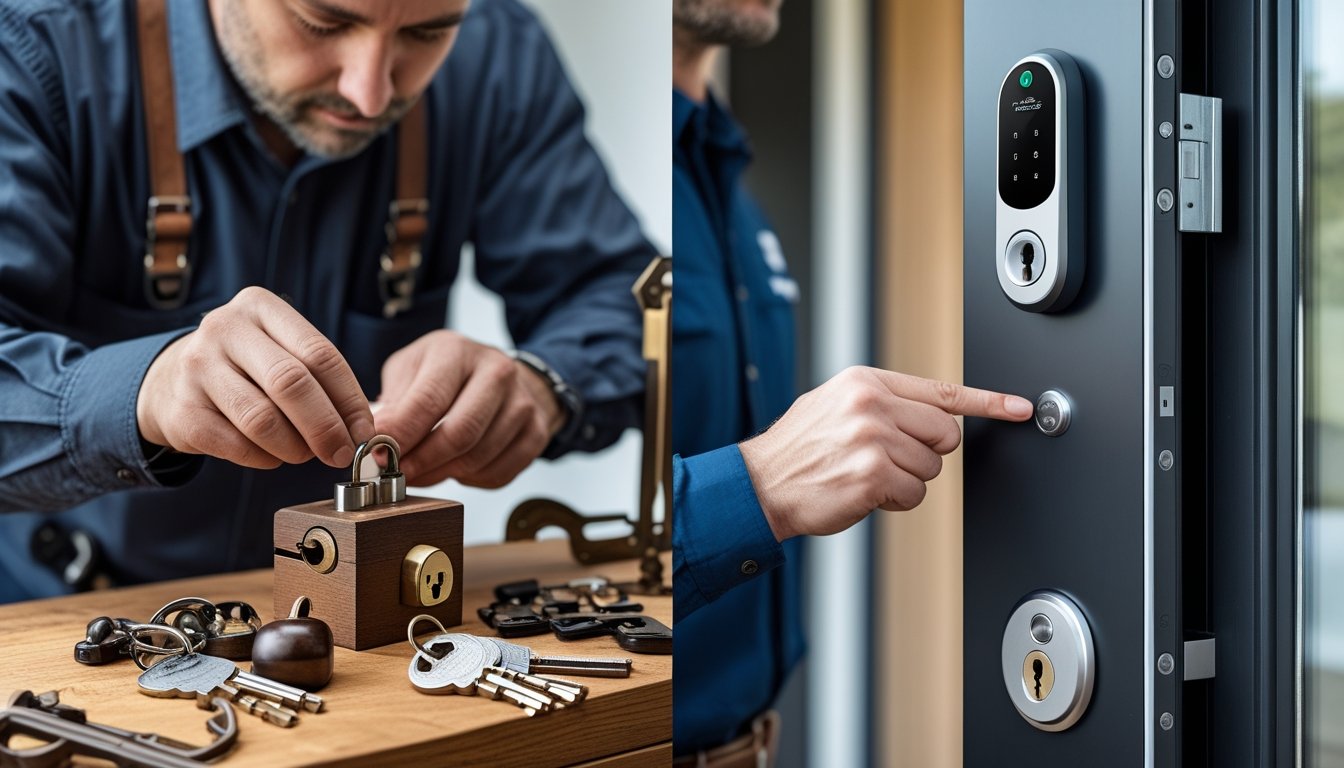Late updated: 30 Oct 2025 12:10
Written by: Elena Prescott
Exploring the Benefits of Traditional Locksmith Methods for Modern Security
Exploring the benefits of traditional locksmith methods takes us back to an era when craftsmanship and simplicity were paramount. In today's fast-paced world of technology, we often overlook the enduring value that classic locks bring to our security needs. Traditional locksmith techniques provide unparalleled reliability and consistency, offering a trustworthiness that modern systems sometimes struggle to match.

We might assume that the latest smart tech is always superior, but there's a timeless reliability found in the use of traditional locks. These methods have safeguarded households for centuries, proving their effectiveness through changing times. Their durability and simplicity make them valuable assets in our comprehensive approach to security.
Engaging with traditional locksmithing is not just about nostalgia, but about recognising and valuing its security benefits. By exploring its core advantages, we can better understand how these time-tested methods earn their place in modern security solutions.
Key Takeaways
- Traditional locksmith methods offer unparalleled reliability.
- They provide effective security solutions alongside modern systems.
- Understanding their value enhances our comprehensive security approach.
Core Advantages of Traditional Locksmith Methods

Traditional locksmith methods offer distinct benefits that modern systems may not fully replicate. From established security to versatile key management, the following points underscore their continued relevance in today’s world.
Proven Security and Reliability
Traditional locks have stood the test of time, providing robust barriers against unauthorised entry. Mechanical locks, such as deadbolts and pin tumbler locks, are commonly used because of their reliability and sturdy construction. These locks do not rely on electricity, making them resistant to power failures and cyber threats. This enduring reliability offers peace of mind, knowing that our security measures maintain functionality even during blackouts.
In our experience, the effectiveness of these locks stems from their straightforward design. Intricate keyways and durable materials make them difficult to tamper with. Moreover, traditional locksmithing techniques allow for tailored security solutions, ensuring that each lock fits specific safety needs. Locksmiths skilled in these techniques can identify weak points and enhance lock systems accordingly.
Key Systems and Access Control
Traditional locksmith methods excel in managing key systems and access control. The use of physical keys allows for clear access delineation, providing effective control over who can enter secure areas. This control is crucial for institutions requiring strict security, such as banks and government facilities. With mechanical locks, the creation, duplication, or revocation of keys is straightforward and cost-effective.
Our approach to access management includes employing warded locks for areas where simple but effective security is sufficient. The tangible nature of physical keys also adds a layer of security, with lost keys immediately prompting a change in lock combinations. This system ensures that any potential breach is swiftly addressed.
Role of Locksmiths in Home Security
Locksmiths play a vital role in home security by implementing and maintaining traditional lock systems. Their expertise in installing and repairing mechanical locks ensures the longevity and effectiveness of security measures. Locksmiths can advise on the most suitable locks for specific home security needs, from high-security deadbolts to more affordable solutions.
Our collaboration with locksmiths highlights their importance in emergency situations. They provide rapid response when locks fail or keys are lost, ensuring continuous security. By choosing traditional locksmithing techniques, we not only maintain robust security systems but also benefit from the professional experience of skilled craftsmen who can handle any lock-related challenge.
Comparing Traditional Methods to Modern Security Solutions

In our exploration of security options, it's essential to evaluate both traditional and modern methods. We're focusing on the limitations of traditional locks, the rise of digital keyless systems, and how these older mechanisms coexist with advanced technology today.
Limitations of Traditional Locks
Traditional locks, while reliable, have inherent limitations. They primarily rely on mechanical mechanisms which can wear over time, increasing maintenance needs. Lock picking and key duplication also remain concerns, making these locks susceptible to breaches.
The lack of real-time monitoring means burglary might go undetected until it's too late. Moreover, conventional locks offer little in terms of remote management, unlike their digital counterparts. Such constraints highlight why some homeowners consider upgrading their security systems.
Transition to Keyless Entry Systems and Smart Locks
The shift to keyless entry and smart locks reflects an evolution in security demands. Smart locks, equipped with electronic locks and access control systems, eliminate many vulnerabilities associated with traditional systems. They provide remote access, allowing us to lock or unlock doors from anywhere using a smartphone or computer.
Access codes offer another layer of security, reducing dependency on physical keys. In addition, these systems can notify us of failed entry attempts instantly, bolstering overall safety. The convenience of keyless systems aligns well with our fast-paced lifestyles and the growing digital age expectations.
The Role of Traditional Locks in the Digital Age
Despite advancements in digital security, traditional locks still play a vital role. They serve as a fundamental layer of protection, often complementing electronic systems. In scenarios where digital security may fail, a well-designed traditional lock can provide immediate fortification.
Some security systems integrate traditional locks with smart technology, creating a hybrid approach. This combination enhances the lock design by incorporating both mechanical reliability and electronic intelligence. Embracing both old and new ensures comprehensive security, keeping our properties safe and secure.
Frequently Asked Questions

In this section, we explore key questions about traditional locksmith techniques and their relevance today. Traditional methods offer unique benefits that digital solutions sometimes miss.
What are the advantages of traditional locksmith techniques compared to modern digital solutions?
Traditional locksmith skills often allow for a personalised approach. These techniques provide more tactile control over lock manipulation. Unlike digital systems, they don't depend on power sources or vulnerable software, making them reliable in different conditions.
How do conventional locksmith methods ensure enhanced security for residential properties?
Conventional locksmith methods focus on mechanical precision and craftsmanship. They are harder to bypass without the right tools and expertise. For many households, the tactile feedback from a well-crafted lock offers reassurance that goes beyond digital codes.
In what ways can historical locksmith skills be applied in contemporary security contexts?
Historical locksmith skills are valuable for customising security solutions. They can integrate into modern systems, offering a hybrid approach that blends technology and craftsmanship. These skills allow us to address niche requirements not covered by standard solutions.
What are the main reasons for the continued training in conventional lock manipulation and key-making?
Training in traditional locksmithing preserves technical skill and craftsmanship. It ensures that new generations can maintain, repair, and create locks without dependency on electronics. This foundation in practical knowledge enables adaptability across varied security needs.
How do traditional lock-picking skills benefit emergency services in access-related scenarios?
Precision and speed can be vital in emergencies. Traditional lock-picking skills allow professionals to access areas quickly without causing damage. These skills provide critical entry access in situations where other methods might fail or be impractical.
What role does the mastery of classic locksmithing play in preserving architectural heritage?
Classic locksmithing helps in the preservation of historical buildings. Mastery of these techniques ensures that authentic features, such as period-specific locks and keys, can be maintained or replicated. This adds to the conservation of architectural heritage, keeping history intact.
